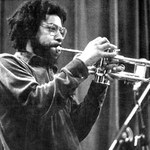Up on eastern Hollywood Boulevard’s Charles Lloyd Wright Hill, a hundred young olive trees danced in the blustery Santa Ana wind and you could see miles away anything with a light on it. Show promoter Rocco Somazzi had ordered the tree frenzy as a contrast to Oguri’s granulated butoh moves; it was art all right.
The three-cornered improvisation began with Oguri groping in tiny increments along the wall behind a jean-jacketed Wadada, who as a kind of fanfare explored the functional theater’s sonic perimeters via trumpet – muting into the floor, raising the bell for ear-boxing blasts that actually hurt. To the left, Motoko Honda in white gown conjured a ghostly fog by reaching into her piano to stroke the low wires.
While you’d expect Wadada’s sound to influence Oguri’s movement and vice versa, the relationship was oblique. More unexpected and more specific was the physical relationship: Oguri orbiting Wadada as Wadada rotated with him; Oguri hiding behind Wadada’s still presence; Wadada shooting Oguri in the back with a trumpet dart from behind the curtain. When they crouched and rose together with a horn punch at one point, it was enough to snap your neck.
Wadada filled every corner with shocks and whispers, his tone variety infinite. Oguri in endless individual slow progress of two hands, two feet, one head, one mouth, crumpling his unstructured Robert Longo suit, turned himself inside out, committed hara-kiri cupping guts in hands, climbed a wall upside-down, froze in midstep an inch off the floor, transformed from a toothless old man screaming in silent pain into a schoolboy standing in humble defiance. This was discipline of a kind few can imagine, executed for freedom.
Honda, meanwhile, colored the air. At my elbow, the eminent aesthetic critic Deborah Drooz couldn’t stop talking later about the elegance and precision with which Honda plucked the exact two internal wires she wanted, spread classically tonal melodies across the keyboard, got discrete percussive effects from objects placed on strings, and extracted loops, echoes and pitch shifts from a small complement of electronic devices. Exuding a quietly intense demeanor, working the pedals with naked foot, she was the embodiment of a Muse. And when she took her bows smiling, she glowed.
It was a microcosm of human interaction -- not as we are, but as we ought to be.

